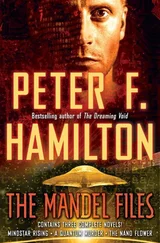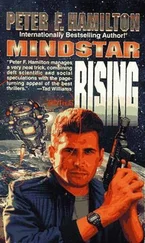The man simply walked up behind the pilot’s chair and slid his head over Chapman’s shoulder, peering out of the narrow curving windscreen. “Where is Atherstone?”
“Look, pal—” Pain lanced deep into his thigh. Chapman grunted roughly at the shock of it. The man’s left index finger was resting lightly on his leg, a small circle of his uniform’s trouser fabric was burning around it.
Chapman swatted at the small blue flames, eyes blinking away sudden tears. His thigh muscle was smarting abominably.
“Where is Atherstone?” the man repeated. “I have to go there.”
Chapman found his calmness more unnerving than the plane’s failure. “Listen, I wasn’t joking when I said we had technical problems. We’re going to be lucky if we make it over this sodding jungle. Forget about Atherstone.”
“I will hurt you again, harder this time. And I will keep on hurting you until you take me to Atherstone.”
I’m being hijacked! The realization was as staggering as it was improbable. Chapman gagged at the man. “You have got to be kidding!”
“No joke, Captain. If you do not land in the capital, I will see to it you don’t land anywhere.”
“Holy Christ.”
“Atherstone. Now where is it?”
“To the west somewhere. Christ, I’m not sure where. Inertial guidance has packed up.”
A mirthless smile appeared on the man’s face. “Then head west. It is a big city. I’m confident we’ll see it from this height.”
Chapman did nothing. Then winced as the man reached past him. He put his hand on the windscreen, palm flat. Horrifyingly deep white cracks splintered outward.
“Atherstone.” It was an order.
“Okay. Just take your goddamn hand off that.” The windscreen was artificial sapphire for God’s sake. You couldn’t crack it by leaning on it. A neural nanonics status check showed him half his synaptic augmentation had crashed, and virtually all the memory cells had shut down. But there was enough capacity for a datavise. “Code F emergency,” he shot at the flight computer. Followed by a small prayer that it hadn’t glitched completely yet.
“ISA duty officer,” came the response. “What’s happening?”
Chapman used the last of his neural nanonics’ capacity to issue a metabolic override, keeping his face perfectly composed. He must not betray the silent conversation by a twitch of emotion. “Attempted hijacking. And the plane’s falling apart around me.”
“How many hijackers?”
“Just one, I think. Can’t access the cabin cameras.”
“What does he want?”
“He says he wants to go to Atherstone.”
“What sort of weapon is he using?”
“Not sure. Nothing visible. Some kind of implant. Maybe a thermal induction field generator. He burnt my leg and damaged the windscreen.”
“Thank you. Hold please.”
Like I can do something else, Chapman thought acidly. He flicked a curious glance at the man who was still standing to one side of the chair. His face was as emotionless as Chapman’s.
The plane rocked alarmingly. Chapman tried to damp it down by swaying the pistol grip to compensate for the erratic motion. On a plane with fully responsive control surfaces it might have worked, here it just slewed the tail around. He noticed the nose had dropped a couple of degrees again.
“If you don’t mind me asking, what’s so bloody important in Atherstone that you’ve got to pull this crazy stunt?”
“People,” the man said blandly.
Some of the man’s calmness was infiltrating Chapman’s own mind. He pulled back on the pistol grip, easing the nose up until they were level again. Nothing to it. At least there were no more systems dropping out, the malfunctions appeared to have plateaued. But landing would be a bitch.
“Chapman,” the ISA duty officer datavised. “Please try and give us a visual of the hijacker. It’s very important.”
“I’m down to about two kilometres altitude, here. Seventy per cent of my systems have failed, and all you want is to see what he looks like?”
“It will help us evaluate the situation.”
Chapman gave the man a sideways glance, loading the image into one of his remaining three functional memory cells. His datavise bit rate was now so low it took an entire second to relay the file.
Ralph Hiltch watched the pixels slowly clot together above the bubble room’s table. “Savion Kerwin,” he said, unsurprised.
“Without a doubt,” Admiral Farquar acknowledged.
“That plane left Pasto ninety minutes after their spaceplane landed,” Jannike Dermot said. “They obviously intend to spread the virus as wide as possible.”
“As I’ve been telling you,” Roche Skark said. “Ralph, do you think he’s infected anyone else on the plane?”
“Quite possibly, sir. The flight computer and Chapman’s neural nanonics are obviously being assaulted by a very powerful electronic warfare field. It might be several of them acting in unison, or it could just be Savion Kerwin’s proximity to the electronic systems, after all the flight computer is housed below the cockpit decking. But we really can’t take the chance.”
“Agreed,” Admiral Farquar said.
Chapman Adkinson waited for fifteen seconds after he’d datavised the visual file. The crippled flight computer reported the communications channel was being maintained. Nothing happened, there was no update from the ISA officer.
A Royal Kulu Navy reserve officer himself, Chapman knew of the response procedures for civil emergencies. Rule of thumb: the longer it took to come to a decision, the higher up the command structure the problem was being bumped. This one must be going right to the top. To the people authorized to make life or death decisions.
Intuition or just a crushing sense of doom, Chapman Adkinson started laughing gleefully.
The man turned to give him a strange look. “What?”
“You’ll see, fella, soon enough. Tell me, are you the biohazard?”
“Am I a—”
The X-ray laser struck the plane while it was still eighty kilometres away from Atherstone. Ombey’s low-orbit SD platform weapons could hit combat wasps while they were still two and a half thousand kilometres distant. The plane was a mere three hundred kilometres beneath the platform which Deborah Unwin activated. Oxygen and nitrogen atoms in the lower atmosphere simply cracked into their sub-atomic constituents as the X ray punched through the air, a searing purple lightning bolt eighty kilometres long. At its tip, the plane detonated into an ionized fog which billowed out like a miniature neon cyclone. Scraps of flaming, highly radioactive wreckage rained down on the pristine jungle below.
He was actually born in the United States of America, though few people ever liked to admit that particular fact, then or afterwards. His parents were from Naples; and Southern Italians were universally looked down on and despised even by other poor immigrant groups, let alone the superior intellectuals of the time who openly stated their hatred of such an inferior breed of humans. As a consequence, few biographers and historians ever admitted the simple truth. He was, above all, a bona fide made in America monster.
His birthplace was Brooklyn, on the chilly winter’s day of January 17, 1899, the fourth son of Gabriele and Teresina. At that time the district was home to a seething mass of such burgeoning immigrant families trying to build fresh lives for themselves in this new land of promise. Work was hard, labour cheap, the infamous city political machine strong, and the street gangs and racketeers prominent. But among all these difficulties his father managed to earn enough to support his family. And as a barber he did so independently and honestly, rare enough in that time and place.
Читать дальше












